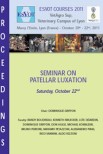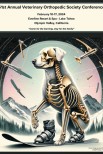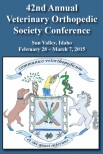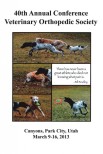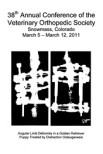 Clare Rusbridge, BVMS PhD DipECVN MRCVS
Clare Rusbridge, BVMS PhD DipECVN MRCVS
Consultant Neurologist, Stone Lion Veterinary Referral Centre.
Wimbledon. London. U.K.
G.S-S. As I recall, you qualified from the University of Glasgow in the early nineties. Had you already made up your mid to specialise in Neurology?, and for tha sake of the readers please ,give them a thumbnail sketch of where you went from there and how you came to be now running your own referral clinic
C.R. When I was a student I actually planned to specialise in pathology and then changed my mind and intended to do exotics however I decided that before pursuing this I wanted to develop a broad base in small animal medicine and surgery. As a final year student I was lucky enough to have a several week externship at North Carolina State University and I was recommended to spend some time in Neurology. As I considered neurology one of my weaker subjects, I thought that I should take advantage of the school’s strength.
I found it a steep learning curve and my fascination for the subject was born. Later during my small animal internship at University of Pennsylvania I obtained permission to return to North Carolina for my neurology rotation as Penn at the time had a part time service that didn’t include neurosurgery. It was there that I met my future mentor Dr. Simon Wheeler and after a year in general small Animal Practice I joined the Royal Veterinary College as his resident; I left there to establish a neurology service at the ‘Stone Lion Veterinary Hospital’ in 1997.
At the time it was rare to have access to MRI for small animals. I was very lucky because a nearby private hospital accommodated us on a daily basis at convenient hours. I was also 10 minutes walk from the local human neurology and neurosurgery hospital - Atkinson Morely. Many of the surgeons and neuroradiologists were very enthusiastic and helpful in allowing me to attend rounds and watch many surgical procedures. Those first few years were like doing a second residency. Although in private referral practice I have always felt it was important to make time for clinical research and I also undertook a part-time PhD from Utrecht University.
I was awarded my doctorate in ‘Canine Chiari malformation and syringomyelia’ in 2007. This research still dominates my life and we continue collaboration with many groups, most notably the University of Montreal where research workers are undertaking the genome work. It has also led to a interest in other inherited neurological disease in particular those that cause neuropathic pain.
G.S-S. I know that you have done a lot of research into feline neurological problems and wonder what your present theme is?
C.R. For the last few years I have been working on Feline Orofacial pain syndrome.
This is neuropathic pain condition is described characterised by episodic, typically unilateral, oral and/or tongue discomfort, triggered in many cases by mouth movements. Burmese cats are predisposed and an inherited disorder affecting trigeminal sensory processing is suspected.
G.S-S. One cannot but expect that by delving into the depth of particular feline condition, you are bound to find yourself becoming involved with similar neurological research in other animals and, of course, the human field?
C.R. Yes I am presenting my findings to the ‘Third International Conference in Neuropathic Pain’ in a few weeks. Inherited neuropathic pain syndromes are rare in humans and the potential to identify the causal mutation and better understand the pathogenesis of neuropathic pain is huge not least because of the potential for pharmacotherapy.
G.S-S. Appreciating your experience and considerable expertise in neurology, I would now like to ask you the following question anticipating that your advice will be of practical use to Veterinary Orthopaedic Surgeons. I am interested in situations of misdiagnosis; when an orthopaedic condition can be mistaken for a neurological condition, and vice-versa, a situation that one sometimes saw in a University referral clinic? Please do not limit your comments to Small Animals; the OVSS has quite a following of Large Animal Orthopaedic Surgeons.
C.R. I think that the most common misdiagnosis of a neurological problem when actually the animal has orthopaedic disease are conditions which involve multiple limbs for example the ‘paraparetic’ that actually has a bilateral cruciate or hip disease for example bilateral femoral neck metaphyseal osteopathy in cats. Occasionally I am inappropriately referred a case because the veteriarian has not taken the basic approach that they would normally because they have been ‘blinkered’ by the breed; for example a Cavalier King Charles Spaniel with an incidental syringomyelia that actually had severe hip dysplasia causing pain and gait disorder. Perhaps a more surprising example is I that often get cases of immune mediated polyarthritis referred to me. Sometimes because there is a meningitis or vertebral articular facet component (i.e. the dog also has spinal pain) but sometimes because the refusal to walk is misinterpreted as inability rather than pain. We have also had some cases with elbow problems which have masqueraded as nerve root lesions. One memorable case required a technetium bone scan to finally prove an elbow lesion in a particularly stoic dog.
As far as neurological cases which present as orthopaedic disease the most common, something which many of the readers will recognise, is nerve root compression or disease for example lumbosacral disease or a nerve sheath tumour. In cats the most common cause of caudal equina or brachial plexus disease is lymphoma.
Orthopaedic surgeons, on the whole, are fairly confident at detecting and treating nerve root lesions and/or spinal disease. Where there can be a problem is in diagnosis of polyneuropathy – a common disorder but one that often does not even make it onto the differential list. Confirmation of polyneuropathy typically requires an electrophysiological evaluation, equipment that an orthopaedic surgeon might not have access to. However, much information might have been gained from a good neurological examination. Sadly in this world of high-tech diagnostic equipment, where referrals can be made for MRI without ever having had a neurological examination, there are some cases where highly expensive and inappropriate diagnostic work-ups have been performed when a proper examination would have suggested the answer at a fraction of the cost. Not all gait abnormalities are best investigated by spinal MRI!
Polyneuropathy can also influence existing orthopaedic disorders with the classic example being the older Retriever with chronic degenerative elbow and hip disease. It is not uncommon for this signalment to also have a polyneuropathy which causes weakness and contributes to the difficulty rising and sustaining exercise. Often these dogs will also have a varying degree of laryngeal paresis. I treat this neuropathy, with variable success, with L-carnitine at 100mg/kg daily in addition to an omega 3, 6, and 9 supplementation.
In some older breeds presenting with polyneuropathy, it is worth investigating for the SOD1 mutation associated with degenerative myelopathy (i.e. what used to be known as CDRM in German Shepherds Dogs) as some breeds, for example the Rhodesian Ridgeback, have predominantly lower motor neuron signs rather than the classical upper motor neuron myelopathy. Ongoing work at the University of Missouri has considerably advanced our ability to diagnose Degenerative Myelopathy (see http://www.cvm.missouri.edu/neurology/dm/index.html). However, it is important to remember that confirmation that a dog has two copies of the mutation is not confirmation of the disease. Other possible contributing or alternative causes of neurological disease should be ruled out. However we all know it is unusual to find an elderly German Shepherd Dogs without a degree of degenerative spinal disease and a problem which both neurologists and orthopaedic surgeons share is deciding what spinal cord disease is significant and what is an incidental finding. A German Shepherd Dog with degenerative myelopathy would have to have a large disc extrusion which fits exactly with the localisation of the signs for me to decide to subject the already compromised spinal cord to surgery.
Orthopaedic surgeons and neurologists often differ in medical management of spinal disease. By there very nature, orthopaedic surgeons like to fix dysfunction with a surgical solution. Consequently they might not explore the possibility of non-surgical alternatives. Medical management options may also be limited - in particular with a heavy reliance on corticosteroids. For example in our experience many cases of syringomyelia are not progressive, especially if the syrinx is small, i.e. not every case with this disease needs be managed surgically and many do well on medical management with drugs that reduce cerebrospinal fluid pressure (e.g. antacids such as cimetidine and omeprazole), non-steroidal anti-inflammatory drugs and adjuvant analgesics such as gabapentin (for more information see http://www.veterinary-neurologist.co.uk). When the surgery for this disease has questionable long-term success it may be more appropriate to treat mild cases medically. As a rule I rarely use corticosteroids when treating spinal cord disease and limit them to immune medicated processes, such as granulomatous meningoencephalomyelitis. Even with this disease corticosteroids are used in combination with other agents and/or radiotherapy.






